Panoramica
NEL 1993-1-1: Progettazione di strutture in acciaio (Eurocodice 3) delinea le linee guida di progettazione per gli elementi strutturali in acciaio da utilizzare negli edifici utilizzando il metodo degli stati limite. La progettazione allo stato limite prevede il confronto dei carichi di progetto fattorizzati con le capacità ridotte delle sezioni e degli elementi. Questi fattori hanno lo scopo di tenere conto della variabilità delle condizioni di carico e delle proprietà dei materiali. Per lo stato limite ultimo (ULS) disegno da soddisfare, la seguente relazione deve essere vera:
\(ULS \;Fattore * Carico ≤ Riduzione \;Fattore * Capacità)
Questa guida alla progettazione delinea la procedura per la progettazione di un elemento strutturale in acciaio in conformità alla norma EN 1993-1-1 usando il NEL 1993-1-1 Design del membro in acciaio modulo.
Guarda il nostro Eurocodice 3 Dimostrazione di progettazione in acciaio
Contenuti
Proprietà dei materiali
Fabbricazione
NEL 1993-1-1 fornisce indicazioni di progettazione per quattro tipi di fabbricazione di acciaio strutturale:
- Sezioni laminate a caldo: Le sezioni laminate a caldo vengono prodotte riscaldando e laminando la billetta di acciaio attraverso un mulino per ottenere la forma richiesta. Gli esempi includono le sezioni I UB/UC/UBP, Sezioni a T, Canali e sezioni angolari.
- Sezioni saldate: Saldato (o fabbricato) le sezioni sono costituite da diverse piastre piane laminate a caldo saldate insieme longitudinalmente per formare una forma di acciaio. Le sezioni fabbricate su misura sono generalmente saldate.
- Sezioni finite a caldo: Le sezioni finite a caldo vengono prodotte riscaldando l'acciaio oltre la sua temperatura di ricristallizzazione prima della laminazione per migliorare la resistenza del prodotto finale. Queste sezioni sono quasi sempre sezioni cave strutturali (RHS/SHS/CHS).
- Sezioni formate a freddo: Le sezioni formate a freddo vengono fabbricate pressando la billetta d'acciaio attraverso un mulino a temperatura ambiente. La formatura a freddo può essere utilizzata per produrre sezioni cave strutturali e sezioni aperte più sottili. Nota EN 1993-1-1 fornisce solo una guida per le sezioni cave formate a freddo.
Grado d'acciaio
L'Europa e il Regno Unito hanno numerose qualità di acciaio (punti di forza) che può essere utilizzato per la progettazione in conformità alla norma EN 1993-1-1. Esistono diversi standard europei sui materiali per diversi tipi di fabbricazione dell'acciaio:
- NEL 10025: Prodotti laminati a caldo.
- NEL 100210: Profilati strutturali cavi finiti a caldo.
- NEL 10219: Profili cavi strutturali saldati formati a freddo.
Sezioni laminate a caldo (NEL 10025)
Di seguito sono descritte le disponibilità di qualità comuni e i limiti di snervamento indicativi per le forme di acciaio laminato a caldo:
Limite di snervamento minimo (MPa) |
|||||||||
|---|---|---|---|---|---|---|---|---|---|
| Grado | ≤16 mm | 16-40mm | 40-63mm | 63-80mm | 80-100mm | 100-150mm | 150-200mm | 200-250mm | 250-400mm |
| S 235 | 235 | 225 | 215 | 215 | 215 | 195 | 185 | 175 | 165 |
| S 275 | 275 | 265 | 255 | 245 | 235 | 225 | 215 | 205 | 195 |
| S 355 | 355 | 345 | 335 | 325 | 315 | 295 | 285 | 275 | 265 |
| S 460 | 460 | 440 | 420 | 400 | 390 | 390 | – | – | – |
Resistenza alla trazione minima (MPa) |
||||||
|---|---|---|---|---|---|---|
| Grado | ≤3mm | 3-100mm | 100-150mm | 150-250mm | 250-400mm | |
| S 235 | 360 | 350 | 350 | 340 | 330 | |
| S 275 | 430 | 410 | 400 | 380 | 380 | |
| S 355 | 510 | 470 | 450 | 450 | 450 | |
| S 460 | – | 550 | 530 | – | – | |
Sezioni cave strutturali finite a caldo (NEL 100210)
Di seguito sono descritte le disponibilità di qualità comuni e i limiti di snervamento indicativi per le sezioni cave strutturali finite a caldo:
Limite di snervamento minimo (MPa) |
||||||
|---|---|---|---|---|---|---|
| Grado | ≤16 mm | 16-40mm | 40-63mm | 63-80mm | 80-100mm | 100-120mm |
| S 235 H | 235 | 225 | 215 | 215 | 215 | 195 |
| S 275 H | 275 | 265 | 255 | 245 | 235 | 225 |
| S 355 H | 355 | 345 | 335 | 325 | 315 | 295 |
Resistenza alla trazione minima (MPa) |
|||
|---|---|---|---|
| Grado | ≤3mm | 3-100mm | 100-120mm |
| S 235 H | 360 | 360 | 350 |
| S 275 H | 430 | 410 | 400 |
| S 355 H | 510 | 470 | 450 |
Prodotto & Resistenza alla trazione
Il carico di snervamento di un materiale è il limite di sollecitazione oltre il quale si verificherà la deformazione plastica. La resistenza alla trazione è la massima sollecitazione che un materiale può sopportare prima di cedere / si rompe. La resistenza allo snervamento e alla trazione delle sezioni di acciaio dipende dal tipo e dallo spessore dell'acciaio. In genere la resistenza aumenta con la qualità dell'acciaio ma diminuisce con l'aumentare dello spessore dell'acciaio.
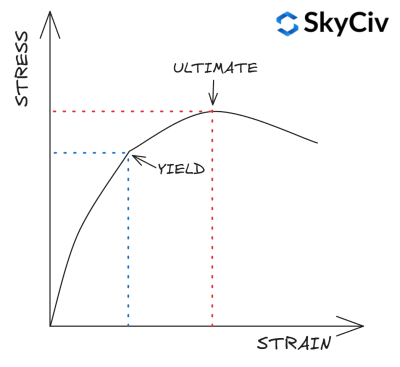
NEL 1993-1-1 tavolo 3.1 fornisce un approccio semplificato per calcolare lo snervamento e la resistenza alla trazione di una sezione in base alla sua qualità e spessore. Un calcolo più dettagliato della resistenza del materiale può essere effettuato facendo riferimento allo standard del materiale pertinente. Il SkyCiv EN 1993-1-1 Il modulo Steel Member Design lo fa non utilizzare questa semplificazione e fare invece riferimento agli standard dei materiali pertinenti per il calcolo della resistenza dei materiali.
Selezione di una sezione in SkyCiv EN 1993-1-1 Design del membro in acciaio
The SkyCiv NEL 1993-1-1 Design del membro in acciaio lo strumento consente agli utenti di selezionare una sezione in acciaio standard dal database SkyCiv o progettare una sezione completamente personalizzata. Il programma calcola automaticamente i valori di resistenza allo snervamento per l'ala della sezione e l'anima in base al tipo di acciaio selezionato. Gli utenti possono anche adottare una qualità di acciaio personalizzata e inserire manualmente le proprietà del materiale, se necessario.
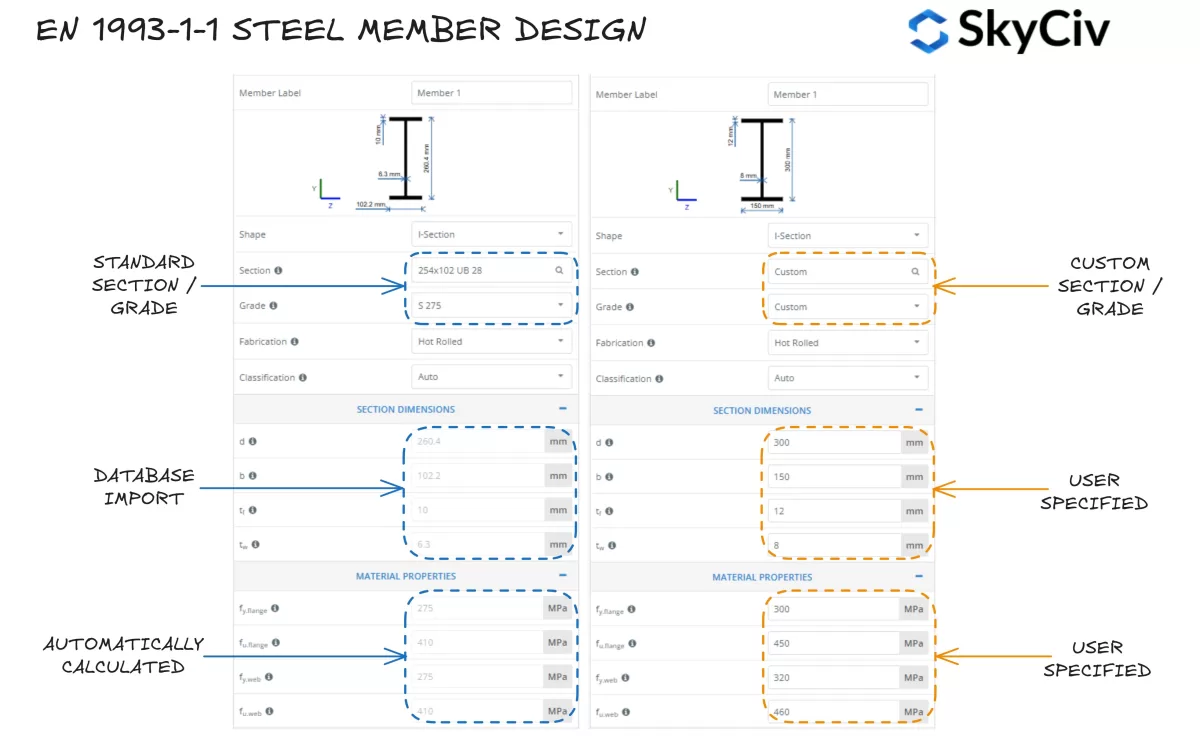
Classificazione della sezione
La classificazione delle sezioni è un sistema utilizzato da EN 1993-1-1 per identificare la suscettibilità di una sezione all’instabilità locale prima di raggiungere la sua piena capacità plastica. Le forme grandi e snelle sono in genere più suscettibili all'instabilità locale rispetto a quelle piccole, forme tozze. The SkyCiv NEL 1993-1-1 Design del membro in acciaio lo strumento calcola automaticamente la classificazione delle sezioni in acciaio standard e personalizzate in base alle condizioni di carico applicate. Eurocodice 3 ha quattro categorie di classificazione delle sezioni:
- Classe 1: Sezioni che possono formare una cerniera plastica e sviluppare il proprio momento plastico/resistenza assiale, ciò significa che l'intera sezione può raggiungere il suo carico di snervamento sotto flessione e/o compressione. Classe 1 le sezioni hanno anche un'elevata capacità di rotazione. Le proprietà della sezione plastica vengono utilizzate nei calcoli della capacità.
- Classe 2: Sezioni con la capacità di formare una cerniera plastica ma con capacità di rotazione limitata. Eurocodice 3 tratta la classe 1 e Classe 2 sezioni in modo simile per quasi tutti i calcoli di capacità.
- Classe 3: Sezioni che possono raggiungere un carico di snervamento nella loro fibra a compressione estrema, ma si deforma localmente prima che venga raggiunto il momento resistente plastico. Le proprietà della sezione elastica vengono utilizzate nei calcoli della capacità.
- Classe 4: L'instabilità locale si verificherà prima che venga raggiunta la resistenza allo snervamento in parte/i della sezione. Le proprietà della sezione elastica ridotta vengono utilizzate nei calcoli della capacità.
Nota, Classe 4 le sezioni includono ulteriore complessità nel calcolo delle proprietà della sezione / resistenza e non sono trattati in questa guida.
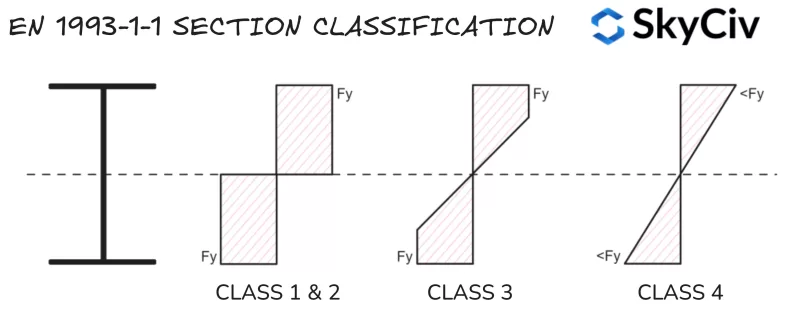
Elementi di compressione
La classificazione della sezione viene determinata suddividendo una sezione in una serie di elementi compressi e calcolandone la snellezza (lunghezza netta rispetto allo spessore). Gli elementi sono classificati come entrambi:
- Interno: Trattenuto contro la deformazione su entrambe le estremità – vale a dire. rete di una sezione I.
- Eccezionale: Trattenuto solo contro la deformazione ad un'estremità – vale a dire. flangia di una sezione a I.
I valori di snellezza calcolati vengono confrontati con la tabella 5.2 nell'EN 1993-1-1 per determinare la loro classe. La classificazione della sezione è considerata quella meno favorevole dei suoi elementi compressi. Nota, la classificazione della sezione cambia a seconda delle forze sulla sezione (forza assiale particolarmente variabile). I metodi per classificare ciascun tipo di carico sono riepilogati di seguito.
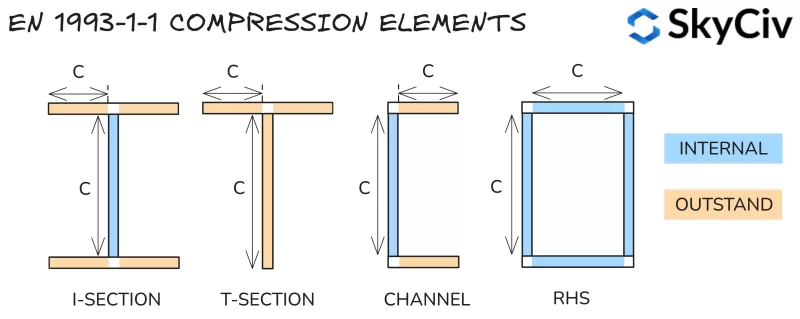
Rapporti di classificazione
Parti soggette a compressione
Gli elementi in pura compressione vengono classificati in base alla loro snellezza utilizzando esclusivamente i limiti di seguito indicati.
| Classe | Parti interne | Parti eccezionali | |
| 1 | c / t ≤ 33ε | c / t ≤ 9ε | |
| 2 | c / t ≤ 38e | c / t ≤ 10ε | |
| 3 | c / t ≤ 42ε | c / t ≤ 14e | |
Dove:
\(ε = qrt{\frac{235}{f_y}}\)
Parti soggette a flessione
Gli elementi interni a flessione pura vengono classificati in base alla loro snellezza entro i limiti di seguito indicati.
| Classe | Parti interne | |
| 1 | c / t ≤ 72ε | |
| 2 | c / t ≤ 83e | |
| 3 | c / t ≤ 124e | |
Gli elementi eccezionali soggetti a flessione pura sono classificati in base al rapporto tra sollecitazione di compressione e trazione sotto il valore del momento flettente risultante in una sollecitazione di compressione pari alla sollecitazione di snervamento sulla fibra estrema. Il metodo per calcolare questo rapporto è dettagliato nella sezione seguente.
Parti soggette a compressione & Flessione
Gli elementi soggetti a compressione e flessione combinata sono classificati in base alla loro compressione / distribuzione delle sollecitazioni di trazione sotto il carico di compressione applicato. Questo rapporto è rappresentato dal simbolo α per la distribuzione delle sollecitazioni plastiche e dal simbolo ψ per la distribuzione delle sollecitazioni elastiche.
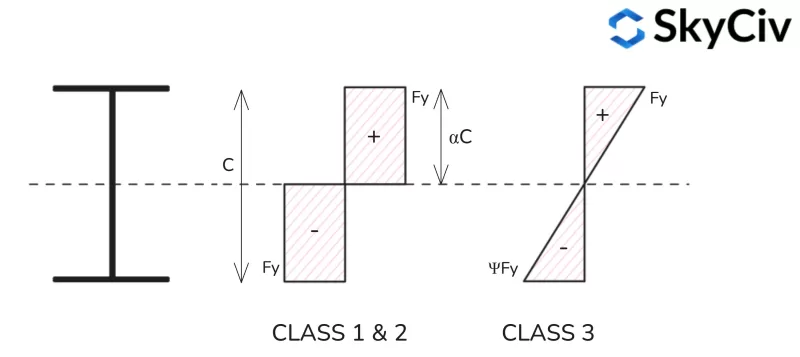
Distribuzione dello stress plastico
Formule per il calcolo del rapporto di sollecitazione plastica (un') per i diversi profili di forma sono forniti di seguito.
Distribuzione delle sollecitazioni plastiche nella sezione I

Distribuzione delle sollecitazioni plastiche nella sezione a T
Notare che le distribuzioni delle sollecitazioni sull'asse minore per le sezioni a T sono simili a quelle di una sezione a I.

Distribuzione delle sollecitazioni nella sezione plastica del canale
Si noti che le distribuzioni delle sollecitazioni sull'asse maggiore per le sezioni a T sono simili a quelle di una sezione a I.

Distribuzione dello stress plastico RHS

Distribuzione elastica delle sollecitazioni
I calcoli della distribuzione delle sollecitazioni elastiche sono simili per tutte le sezioni e forme, a causa della distribuzione lineare dello stress tra le fibre estreme. Di seguito è riportata la formula per calcolare la sollecitazione minima in una sezione sottoposta a compressione e flessione.
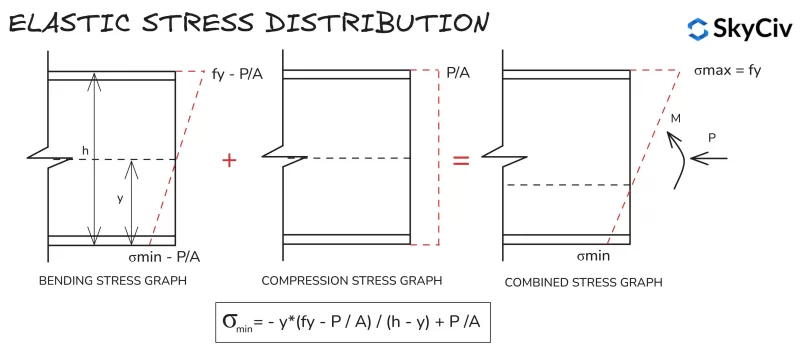
Classificazione delle sezioni in SkyCiv EN 1993-1-1 Design del membro in acciaio
La SkyCiv UNO 1993-1-1 Design del membro in acciaio lo strumento determina automaticamente la classificazione delle sezioni standard e personalizzate in base al caricamento dell'input dell'utente. Un esempio di output per un Grado S 275, 430Di seguito viene descritto in dettaglio il canale x100x64 con 20 kN di carico di compressione.
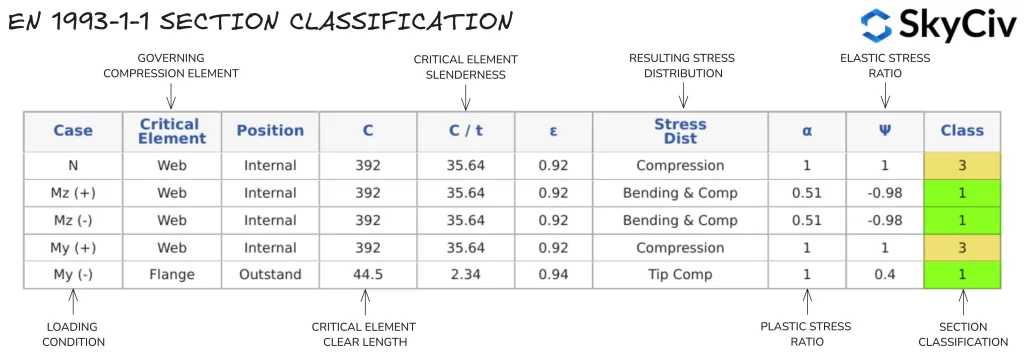
Per tutti i calcoli viene utilizzato un singolo valore di classificazione della sezione in base alla forza assiale applicata e alla direzione del momento flettente applicato. Se a un membro è applicato un momento flettente attorno a entrambi gli assi, viene adottata la classificazione più conservativa da ciascuna direzione. Gli utenti possono anche sovrascrivere il calcolo automatico della classificazione della sezione e specificare manualmente una classificazione.
Nota, Clausola 5.4.1(3) specifica che le sezioni singolarmente simmetriche (come sezioni a T e canali) non possono essere progettati utilizzando l'analisi plastica quando piegati attorno al loro asse non simmetrico. Pertanto alle sezioni di questa natura viene automaticamente assegnata la Classe 3.
Sezione Resistenza
Flessione
Resistenza alla flessione della sezione
La capacità del momento flettente della sezione viene calcolata utilizzando EN 1993-1-1 Clausola 6.2.5.
\(M_{c,Rd} = W*f_y/γ_{M0}\)
Dove W è il modulo di resistenza plastica (WResistenza della sezione in compressione) per Classe 1 & 2 sezioni, ovvero il modulo di resistenza elastica (Wil) per Classe 3 sezioni, fy è il carico di snervamento del materiale e γ è il fattore di riduzione parziale di sicurezza.
Il modulo di sezione di una forma è una proprietà geometrica che quantifica la resistenza alla flessione di una forma. Il modulo della sezione plastica presuppone che l'intera sezione raggiunga la sua resistenza allo snervamento sotto flessione. Il modulo di sezione plastica di una sezione viene calcolato come segue:
\(Angolo di attrito{Resistenza della sezione in compressione} = A_{C} * y_{C} + UN_{T} * y_{T} \)
Dove unC e AT sono le aree su entrambi i lati dell’Asse Neutrale Plastico (ANNA), e yc / yt sono la distanza dal PNA al baricentro di quelle aree. Nota, la posizione del PNA è uguale alla posizione del baricentro geometrico per le forme simmetriche ma lo farà non uguale alla posizione del baricentro geometrico per le forme asimmetriche.
Il modulo elastico di sezione assume l'intera sezione (forma) rimane elastico sotto flessione, vale a dire. nessuna parte della sezione supera il limite di snervamento (fy) del materiale. Il modulo elastico di una sezione si calcola come segue:
\(Angolo di attrito{il} = frac{I}{y}\)
Dove I è il momento secondo dell'area e y è il baricentro geometrico della forma. Nota per una forma asimmetrica, il valore del modulo elastico utilizzato nella progettazione è il valore minore per la flessione positiva e negativa attorno a quell'asse.
Calcolo della resistenza alla flessione della sezione in SkyCiv EN 1993-1-1 Design del membro in acciaio
Una volta calcolata la relativa Classificazione di Sezione, il modulo calcola la capacità del momento flettente della sezione (Mc) attorno a ciascun asse principale. I risultati per lo stesso canale 430x100x64 sono mostrati nell'esempio seguente.

cesoia
Sezione Resistenza al taglio
La resistenza al taglio viene calcolata utilizzando EN 1993-1-1 Clausola 6.2.6. I calcoli della capacità dipendono dalla classificazione della sezione dell'elemento in acciaio. Capacità per classe 1 & 2 le sezioni sono calcolate in base alla resistenza plastica a taglio, mentre per la Classe viene utilizzata una resistenza elastica a taglio 3 & 4 sezioni.
La resistenza al taglio plastica viene calcolata utilizzando la formula seguente:
\(V_{Resistenza della sezione in compressione,Rd}=A_v * (f_y / \sqrt{3}) / C_{M0}\)
Dove Av è l'area di taglio della sezione nella direzione della forza di taglio applicata. Per la maggior parte delle sezioni quest'area è equivalente all'area dell'anima per il taglio nella direzione dell'asse maggiore, e l'area delle flange per l'altra direzione. Le formule per il calcolo dell'area di taglio sono fornite nella norma EN 1993-1-1 Clausola 6.2.6(3).
La resistenza elastica al taglio viene calcolata utilizzando la relazione seguente, che garantisce che lo sforzo di taglio nel punto critico della sezione trasversale sia inferiore allo sforzo di snervamento.
\(T_{Ed}/(f_y / (\sqrt{3 * C_{M0}})) ≤ 1\)
Lo sforzo di taglio in questo punto critico viene calcolato come segue:
\(T_{Ed}=(V_{Ed} * S)/(I * t)\)
Dove VEd è la forza di taglio applicata, S è il primo momento dell'area, I è il momento della sezione dell'area e t è lo spessore nel punto critico di sollecitazione.
La formula della sollecitazione di taglio elastico può quindi essere predisposta per rappresentare un valore di resistenza (in kN):
\(V_{il,Rd} = (I * t * \sqrt{3})/(S * f_y)\)
Instabilità a taglio
Lungo, le anime sottili possono deformarsi sotto la forza di taglio applicata prima che raggiungano la loro resistenza elastica al taglio. Le anime sono suscettibili all'instabilità per taglio se soddisfano la formula EN riportata di seguito 1993-1-1 Clausola 6.2.6(6):
\(h / t > 72 * sì/no \)
Dove η è un fattore solitamente considerato come 1.0. Le anime suscettibili di instabilità a taglio devono essere controllate in conformità alla Sezione 5 o AND 1993-1-5. Nota, capacità di taglio secondo EN 1993-1-5 non è coperto da SkyCiv EN 1993-1-1 attrezzo, ma verrà visualizzato un avviso se una sezione è suscettibile di instabilità a taglio.
Impatto della forza di taglio sulla flessione & Resistenza alla compressione
Una forza di taglio applicata elevata può avere un impatto negativo sul momento e sulla resistenza assiale di una sezione. Nell'EN 1993-1-1, questo impatto viene catturato riducendo la resistenza allo snervamento della sezione rispetto all'entità del taglio applicato (fare riferimento alla clausola 6.2.8 & 6.2.10). Quando la forza di taglio della sezione è meno di metà della sua resistenza plastica al taglio in quella direzione, questo impatto può essere trascurato. Se il taglio applicato è maggiore di questo valore, il carico di snervamento ridotto viene calcolato come segue:
\(f_{y,Rd} = (1 -Capacità di compressione di una corda di fondo in una capriata del tetto soggetta a sollevamento del vento) * f_y \)
Dove:
\(ρ = (2 * V_{Ed} / V_{Resistenza della sezione in compressione,Rd} – 1)^2)
La SkyCiv UNO 1993-1-1 Design del membro in acciaio il modulo calcola automaticamente qualsiasi riduzione del carico di snervamento dovuta all'elevata forza di taglio applicata e utilizza questo valore ridotto nei calcoli della resistenza alla flessione e alla compressione della sezione. Nota, tale riduzione si applica solo alla resistenza sezione di un'asta, non la resistenza all'instabilità.
Calcolo della resistenza al taglio in SkyCiv EN 1993-1-1 Design del membro in acciaio
La SkyCiv UNO 1993-1-1 Design del membro in acciaio lo strumento calcola la capacità di taglio di una sezione in entrambe le direzioni dell'asse principale. Risultati dai calcoli della resistenza al taglio per un 254×102 Puoi trovare una gamma di tipi di connessione che soddisfano le tue esigenze senza dover occuparti di sistemi di interfaccia utente disordinati che richiedono una curva di apprendimento ripida per iniziare 28 sono dettagliate di seguito.

Compressione
Sezione Resistenza alla compressione
NEL 1993-1-1 Clausola 6.2.4 calcola la capacità di compressione (Nc) di una Classe caricata concentricamente 1,2 o 3 sezione come segue:
\(N_{c,Rd} = A*f_y / C_{M0}\)
Dove A è l'area lorda della sezione trasversale e fy è il carico di snervamento della sezione.
Calcolo della resistenza alla compressione della sezione in SkyCiv EN 1993-1-1 Design del membro in acciaio
La SkyCiv Uno 1993-1-1 Design del membro in acciaio lo strumento calcola la resistenza alla compressione della sezione (Nc,Rd) per sezioni europee standard e sezioni personalizzate definite dall'utente. Risultati dai calcoli della resistenza alla compressione della sezione per un 254×102 Puoi trovare una gamma di tipi di connessione che soddisfano le tue esigenze senza dover occuparti di sistemi di interfaccia utente disordinati che richiedono una curva di apprendimento ripida per iniziare 28 sono dettagliate di seguito.

Tensione
Sezione Resistenza alla tensione
NEL 1993-1-1 Clausola 6.2.3 calcola la capacità di un'asta tesa (Non) essere il minore tra la resistenza plastica alla trazione e la resistenza alla trazione ultima:
\(N_{t,Rd} = minimo(A*f_{y}/C_{M0} \; ,\; 0.9*UN_{n}*f_u /γ_{Eurocodice di design con piastra di base in acciaio})\)
Dove A è l'area lorda della sezione, An è l'area netta della sezione trasversale (area lorda esclusi attraversamenti/fori), fy è il forza di snervamento della sezione, fu è il trazione (ultimo) forza della sezione.
Calcolo della resistenza alla tensione in SkyCiv EN 1993-1-1 Design del membro in acciaio
La SkyCiv UNO 1993-1-1 Design del membro in acciaio il modulo presuppone che non siano presenti buchi significativi nella sezione, quindi An è considerato uguale ad A. Risultati dai calcoli della resistenza alla tensione della sezione per un 254×102 Puoi trovare una gamma di tipi di connessione che soddisfano le tue esigenze senza dover occuparti di sistemi di interfaccia utente disordinati che richiedono una curva di apprendimento ripida per iniziare 28 sono dettagliate di seguito.

Flessione & Forza assiale
Quando a una sezione è stata applicata una tensione assiale o una forza di compressione, si dovrebbe tenere conto dell'effetto di questa forza sulla resistenza al momento flettente della sezione. Il metodo per valutare questo effetto delineato in EN 1993-1-1 Clausola 6.2.9 varia in base alla classe 1 & 2 e Classe 3 sezioni.
Classe 1 & 2 sezioni
La forza combinata di flessione e assiale viene valutata per le sezioni in plastica riducendo il momento resistente plastico in ciascuna direzione di una quantità proporzionale alla forza assiale. Questo momento resistente ridotto è indicato con il simbolo MN,Rd. Calcolo di MN,Rd varia a seconda della forma della sezione ed è delineato nella norma EN 1993-1-1 Clausola 6.2.9.1. Una volta ridotta la resistenza al momento viene calcolata, il seguente criterio viene utilizzato per valutare la resistenza combinata a flessione e assiale:
\( (M_{y,Ed} / M_{IL,Rd})^a + (M_{z,Ed} / M_{NZ,Rd})^ b ≤ 1\)
Dove α e β sono costanti che variano con la forma della sezione – Fare riferimento a IT 1993-1-1 Clausola 6.2.9.1.
Classe 3 sezioni
La forza combinata di flessione e assiale nelle sezioni elastiche viene invece valutata utilizzando una formula generale di sollecitazione elastica dettagliata di seguito:
\( N_{Ed} / N_{c,Rd} + M_{z,Ed} / M_{cz,Rd} + M_{y,Ed} / M_{ci,Rd} ≤ 1\)
Si noti che qualsiasi riduzione del carico di snervamento richiesta a causa della forza di taglio applicata deve essere utilizzata nel calcolo dei valori di resistenza della sezione nelle formule di cui sopra.
Resistenza all'instabilità
Flessione
Resistenza all'instabilità torsionale laterale
Lungo, gli elementi in acciaio non vincolati possono cedere per instabilità flesso-torsionale prima di raggiungere la resistenza al momento flettente della sezione. L'instabilità torsionale laterale si verifica quando la sezione ruota dal suo asse maggiore verso il suo asse minore, ciò significa che il momento resistente nella direzione della flessione applicata è ridotto. La guida per il calcolo della resistenza all'instabilità flesso-torsionale dell'elemento è fornita nella norma EN 1993-1-1 Clausola 6.3.2.
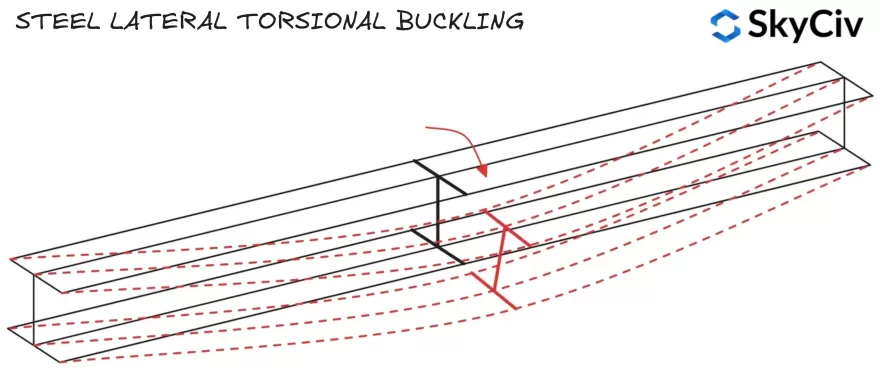
La resistenza all'instabilità torsionale laterale viene calcolata utilizzando la formula seguente:
\(M_{b,Rd} = x_{Verifica dell'ACI}*W*f_y/ γ_{M1}\)
Dove W è il modulo di resistenza plastica (WResistenza della sezione in compressione) per Classe 1 & 2 sezioni, o modulo elastico (Wil) per Classe 3 sezioni. HVerifica dell'ACI è un fattore di riduzione per l’instabilità flesso-torsionale, la guida per il calcolo di questo fattore è fornita in EN 1993-1-1 Clausola 6.3.2.2 e 6.3.2.3.
Flangia di compressione
Gli elementi falliscono nell'instabilità flesso-torsionale quando la flangia di compressione ruota e si sposta lateralmente. Se la flangia di compressione di un elemento è sufficientemente trattenuta, non sarà suscettibile all'instabilità torsionale laterale (Fare riferimento a IT 1993-1-1 Clausola 6.3.2.1(2)). Di seguito sono mostrate le posizioni delle flange di compressione per le sezioni standard sotto carico verticale.
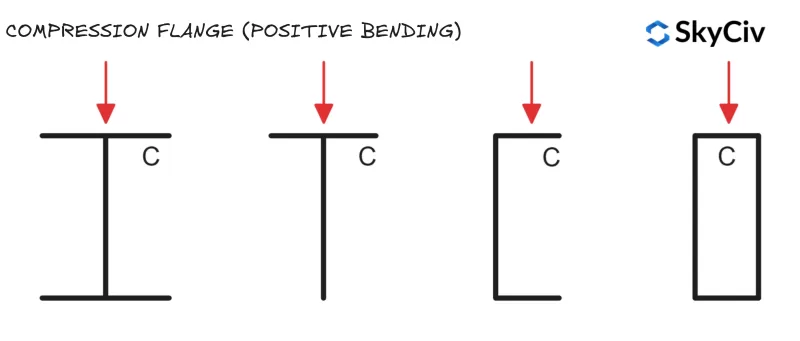
Sezioni cave circolari (CHS) e sezioni cave quadrate (SHS) non sono suscettibili di instabilità torsionale laterale, poiché hanno un momento resistente di sezione uguale su entrambi gli assi (ciò significa che lo spostamento laterale e la rotazione non influiscono sulla resistenza alla flessione dell'elemento).
Fattore di riduzione della deformazione torsionale laterale
HVerifica dell'ACI è calcolato in en 1993-1-1 usando entrambe le sezioni 6.3.2.2 (Caso generale) o sezione 6.3.2.3 (Sezioni arrotolate o sezioni saldate equivalenti). Sezione 6.3.2.3 è applicabile per tutti “standard” sezioni e forme (comprese sezioni vuote) e i loro equivalenti saldati. Sezione 6.3.2.2 è applicabile a qualsiasi sezione che non rientra nella prima categoria, tra cui sezioni personalizzate e costruite.
Sezione 6.3.2.2 usa l'equazione 6.56 per il calcolo della riduzione della destalla torsionale laterale fattiVerifica dell'ACI mentre la sezione 6.3.2.3 usa l'equazione 6.57. La SkyCiv UNO 1993-1-1 Design del membro in acciaio Il modulo segue la logica descritta di seguito per l'applicazione dell'equazione 6.56 e 6.57.
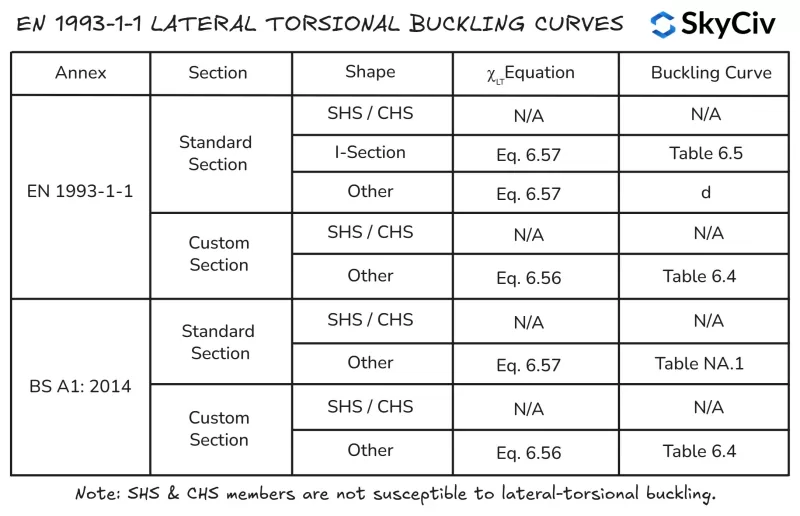
Resistenza alla flessione dell'asse minore
La capacità di flessione di un elemento piegato attorno al suo asse minore è uguale alla resistenza della sezione dell'asse minore attorno a quell'asse. La capacità della sezione dell'asse minore è la capacità minima che una sezione può raggiungere attorno a qualsiasi asse, quindi l'elemento non può ruotare da questo asse in un orientamento meno favorevole.
Calcolo della resistenza alla flessione dell'elemento in EN 1993-1-1 Design del membro in acciaio
La SkyCiv UNO 1993-1-1 Design del membro in acciaio Lo strumento calcola esegue i calcoli della resistenza alla torsione laterale in conformità alla norma EN 1993-1-1 Clausola 6.3.2.2 e clausola 6.3.2.3, a seconda della forma della sezione e dell'allegato nazionale applicato. Gli utenti hanno anche la possibilità di specificare un membro come avente “Vincolo torsionale continuo” che salterà automaticamente tutti i controlli di instabilità flesso-torsionale. Calcoli della resistenza all'instabilità torsionale laterale per un 254 lungo 5000 mm×102 Puoi trovare una gamma di tipi di connessione che soddisfano le tue esigenze senza dover occuparti di sistemi di interfaccia utente disordinati che richiedono una curva di apprendimento ripida per iniziare 28 sono dettagliate di seguito.

Compressione
Resistenza all'instabilità flessionale
La resistenza all'instabilità in compressione di un elemento è influenzata anche dalla sua lunghezza e dalla rigidità laterale. Sfrenato, è probabile che gli elementi più lunghi cedano a causa dell'instabilità per flessione prima della sezione (schiacciare) la capacità è raggiunta. NEL 1993-1-1 Clausola 6.3.1.3 fornisce indicazioni sul calcolo della resistenza all'instabilità flessionale dell'elemento per la Classe 1, 2 & 3 sezioni trasversali:
\(N_{b,Rd} = x*A*f_y/ γ_{M1}\)
Dove χ è un fattore di riduzione per l'instabilità flessionale. La guida per il calcolo di questo fattore è fornita in EN 1993-1-1 Clausola 6.3.1.3. Fla capacità lessicale deve essere verificata su entrambi gli assi per trovare il valore determinante per il membro.
Calcolo della resistenza all'instabilità flessionale in EN 1993-1-1 Design del membro in acciaio
La SkyCiv UNO 1993-1-1 Design del membro in acciaio lo strumento calcola la resistenza all'instabilità flessionale attorno a entrambi gli assi principali in base alle lunghezze di vincolo e ai fattori di lunghezza effettiva specificati dall'utente. Resistenza all'instabilità flessionale di un 254×102 Puoi trovare una gamma di tipi di connessione che soddisfano le tue esigenze senza dover occuparti di sistemi di interfaccia utente disordinati che richiedono una curva di apprendimento ripida per iniziare 28 con lunghezza libera di 6000mm e 5000mm sugli assi Z e Y (rispettivamente) sono dettagliate di seguito.

Resistenza all'instabilità torsionale-flessionale
Le sezioni trasversali aperte sono anche suscettibili di instabilità torsionale-flessionale, che può essere inferiore alla resistenza dell’elemento all’instabilità flessionale. Sezioni cave circolari (CHS) e sezioni cave quadrate (SHS) le membrature non sono suscettibili di instabilità torsionale-flessionale. NEL 1993-1-1 Clausola 6.3.1.4 fornisce indicazioni sul calcolo della resistenza all’instabilità torsionale-flessionale degli elementi:
\(N_{bT,Rd} = χ_T*A*f_y/ γ_{M1}\)
Dove HVerifica dell'ACI è un fattore di riduzione per l’instabilità flesso-torsionale. La guida per il calcolo di questo fattore è fornita in EN 1993-1-1 Clausola 6.3.1.3. Fla capacità lessicale deve essere verificata su entrambi gli assi per trovare il valore determinante per il membro.
Calcolo della resistenza all'instabilità torsionale-flessionale in EN 1993-1-1 Design del membro in acciaio
La SkyCiv UNO 1993-1-1 Strumento di progettazione degli elementi in acciaio calcola la resistenza all'instabilità torsionale-flessionale per le sezioni aperte e chiuse applicabili in conformità alla norma EN 1993-1-1 Clausola 6.3.1.4 in base alla lunghezza del vincolo di compressione nell'asse maggiore come specificato dall'utente. Resistenza all'instabilità torsionale-flessionale di un 254×102 Puoi trovare una gamma di tipi di connessione che soddisfano le tue esigenze senza dover occuparti di sistemi di interfaccia utente disordinati che richiedono una curva di apprendimento ripida per iniziare 28 con una lunghezza non vincolata di 6000 mm sono descritti di seguito.

Software di progettazione strutturale SkyCiv
SkyCiv offre una vasta gamma di software di analisi strutturale e progettazione ingegneristica, Compreso:
-
- Eurocodice 3 Design in acciaio
- Eurocodice 9 Design in alluminio
- Eurocodice 3 Progettazione dell'arcareccio
- Eurocodice 3 Calcolatore del gruppo di bulloni
- Eurocodice 3 Calcolatore del gruppo di saldatura
- Eurocodice 2 Calcolatore della lunghezza di sviluppo
- Eurocodice 2 Calcolatore della lunghezza del giro
- Eurocodice 5 Calcolatore per la progettazione del legno
- Eurocodice 3 Calcolatore per la progettazione di impalcature
Sviluppatore di software | Ingegnere strutturale
BEng (Civile), DipEng (Software)



